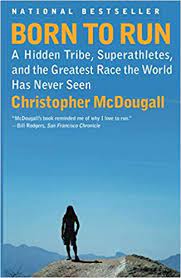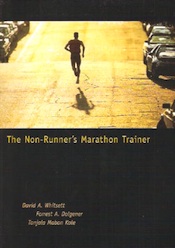I’m in training. For a marathon! Yeah, you read that right, and it still sounds as unbelievable to me as it does to anyone reading this who knows me.
Sure, I wrote earlier about starting a running program; I began running again this spring rather stupidly. I just started jogging, and tried way too quickly to extend my runs. I didn’t begin by getting my body to get used to the idea of moving first, by walking, then gradually adding jogging, and slowly, smartly building up my bones and muscles from those of Internet potato to jock wannabe.
And after I finished my 5k race in May, I slacked off, and stopped running again, although with geocaching as a hobby, I’ve been getting outside and moving a bit more than I used to.
 Fast-forward to the present: Almost everyone on my team at work (yeah, fellow geeky Web developers and engineers!) has been reading either Born to Run by Christopher McDougall, or The Non-Runner’s Marathon Trainer by Whitsett, Dolgener and Kole, or both.
Fast-forward to the present: Almost everyone on my team at work (yeah, fellow geeky Web developers and engineers!) has been reading either Born to Run by Christopher McDougall, or The Non-Runner’s Marathon Trainer by Whitsett, Dolgener and Kole, or both.
The first book is about ultra-marathoning, and deals with the subject on two levels. First, it’s a brilliantly-written account of its practitioners, from the Tarahumara people of Mexico, to some of the most colorful characters in the the States that you’ll ever read about.
The second level is a examination of the science of running, which is no less interesting, and to me, was even more so. One mystery that McDougall was intent on solving, is why US distance running capability has been decreasing since the 70s.
Over the course of his investigation, with discussions ranging from sport science laboratories to casual conversations with extreme runners, a pattern emerged that running injuries exploded proportionately with the advent of running shoes, and a rapidly-growing segment of doctors, coaches, and runners are eschewing shoes for barefoot running or minimal footwear, such as Vibram FiveFingers.
The results (for many people at least) have been remarkable. Some people with debilitating running injuries have been quickly able to surpass their previous abilities, and there are coaches now who insist their athletes train barefoot to prevent injuries.
I had decided to order a pair of FiveFingers long before reading Born to Run, and the book only increased my interest. Last week, I received my VFFs and the feeling was amazing—exactly like being barefoot, but with protection from the glass, stickers, and pebbles that make city streets foot-hostile. Alas, my shoes were a size too small, but I’m looking forward to getting the right size later this week.
 Meanwhile, I’m following the Non-Runner’s Marathon Trainer. It’s from 1998, so naturally doesn’t have the latest and greatest information about footwear, but it seems a sane (though still scary) guide to get a non-runner like me to complete a marathon. The marathon-training program is 16 weeks long (about the length of a college semester, which is where this approach was developed originally). There’s also a more basic 10-week program to prep complete non-runners to have the strength and stamina for the training program. Needless to say, I’m in that preparatory phase.
Meanwhile, I’m following the Non-Runner’s Marathon Trainer. It’s from 1998, so naturally doesn’t have the latest and greatest information about footwear, but it seems a sane (though still scary) guide to get a non-runner like me to complete a marathon. The marathon-training program is 16 weeks long (about the length of a college semester, which is where this approach was developed originally). There’s also a more basic 10-week program to prep complete non-runners to have the strength and stamina for the training program. Needless to say, I’m in that preparatory phase.
All in all, this is pretty amazing stuff. More and more, we’re realizing that the corporate-controlled running shoe industry is slowing us down and killing our feet, that our God-given arches and natural pronation is the best shock absorption possible, and that what we’ve had all along is all we ever really needed.
 This renewed attention to the bare foot makes me think of one in particular: the empty footprint. As Karen Armstrong wrote, the first symbol of Buddhism wasn’t the Buddha-image, but the Buddha’s footprint. That, to me, is a wonderful illustration of the impact of spirit and mind upon matter, more distinguished by what’s not there than what is there.
This renewed attention to the bare foot makes me think of one in particular: the empty footprint. As Karen Armstrong wrote, the first symbol of Buddhism wasn’t the Buddha-image, but the Buddha’s footprint. That, to me, is a wonderful illustration of the impact of spirit and mind upon matter, more distinguished by what’s not there than what is there.



